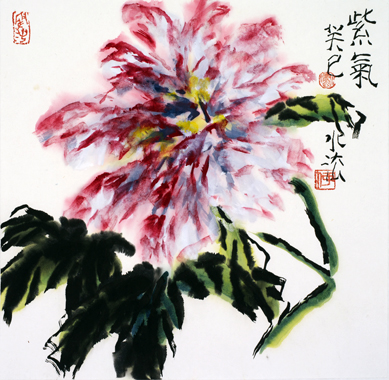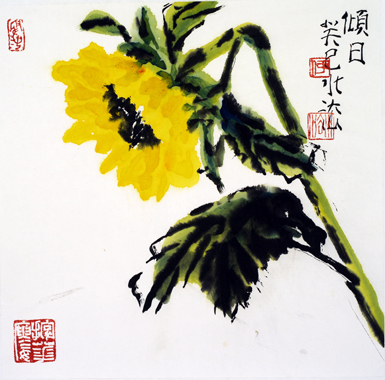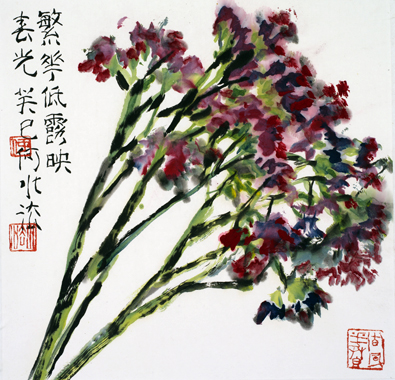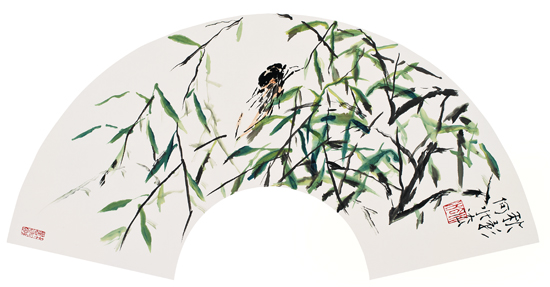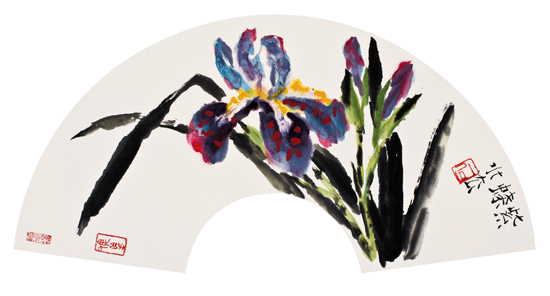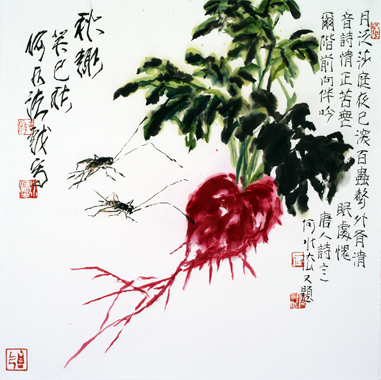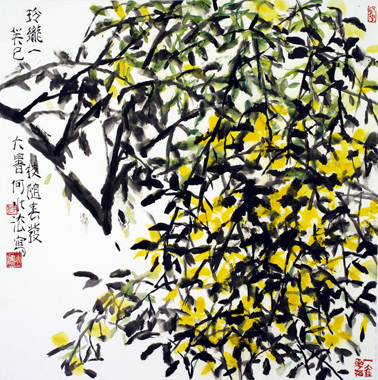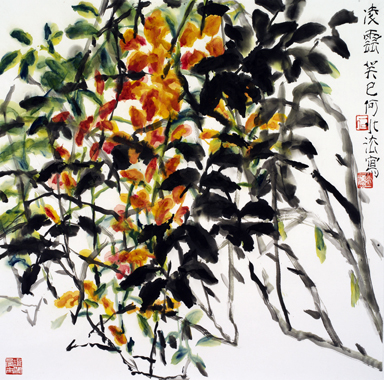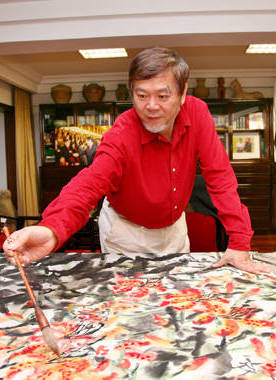 He Shuifa
He Shuifa
Born in Hangzhou in August 1946, 1980 Graduated from China Academy of Art, Department of Chinese Painting birds and flowers Postgraduate cources. Is now the CPPCC National Committee members, CPPCC Zhejiang Provincial Committee, Standing Committee, Zhejiang Provincial People's Government counselor, member of Chinese Artists Association council, member of Chinese Painting Art Committee of Chinese Artists Association, Chinese Painting Society executive director, Zhejiang super expert, vice director of Zhejiang Artists Committee, The Ministry of Culture, Graduate School of Chinese National Academy of Arts Professor, Doctoral tutor, Xiling Seal Society director, Ukraine Lviv National Academy of Arts Honorary Doctorate, Honorary president of Fujian Provincial Art Gallery, Fuzhou Painting honorary president, Hanghzou Normal University, honorary president, Luoyang Painting honorary president, Luoyang Normal University, honorary president, At the national level artist, enjoying the State Council special allowance.
Long before He Shuifa got to know me, I had known about him a lot. It was a prime summer in 2003 when a newspaper in Hangzhou organized a salon consisting of writers and painters. In a program of group creation of Chinese painters, He Shuifa was the 1st painter to start the creation. He painted a batch of peony in a short time and then left in graceful manners with beautiful appreciation for us. His tall figure and white beard under the chin impressed me deeply. One of my friends who invited me whispered, “He Shuifa is a master of flower-and-bird painting and big shot in Zhejiang.” “He seems to be a bit arrogant.” I replied. “It’s true, but he will be mild if you are a compatible man in his eyes”, my friend said. “Oh? He looks quite like a master!” I joked because at that time many middle-aged people in art circles pretended to be qualified master only wearing beard. Of course in retrospect, I must admit that it was totally my prejudice arising from my doubt with the relationship between beard and being a master. It is purely a personal matter whether to wear beard or not, which has nothing to do with his character. It is not all those pretender that wear beard, or it is not all those who wear beard that want to pretend to be a master. Similarly, there are indeed many masters with beard and many without beard. However, I have to admit that He Shuifa’s beard is so special that I easily memorize his appearance in my mind. You know, I always fail to recognize those I have met with several times before, but I will always remember He Shuifa’s hard beard with grey and white in between and his resolute vision.
The second time I met him, it was an evening in late autumn in 2010, when foreign language institute of Social Science Academy held banquet with all the writers and participants in the 2nd China Japan Young Writers’ Forum. I was then invited to deliver improvised speech. In the banquet hall, I found a painting of peony by He Shuifa, a voluntary creation he donated for publication of Chinese and Japanese young writers. I appreciated the painting as well as its author, who was still in resolute spirits with his unchanged beard. By that time, I had known quite a lot about his achievement and countless virtuous acts, and I began to admire his artistry and lofty character. I never dare to treat myself as his friend, but I always rejoice in being his fans. The other day, learning that Chen Liming, a publisher, would complie a book about He Shuifa, I took the initiative to say something about his painting just from an angle of a layman or an ordinary spectator of traditional Chinese painting.
As I mentioned previously, I just witnessed one painting of his and a flash of his creation in my own eyes, which almost made my comments ridiculous to others. Fortunately, I can find lots of his paintings and reference books online. Though the visual effect and condition is far beyond the genuine painting, I can spend much time in savoring once and over at my convenience. With limited time of appreciation, I gathered my courage and confidence to utter my opinion.
Personally, I like his painting, either the fine and detailed flowers and birds in his early creation or the color ink freehand works in recent years. I favor his personality as well though I have hardly communications with him. I have known many praises over him from many friends of mine and got to know his benevolent acts from media. For example, he advocated holding a joint exhibition of Dwelling at Fuchun Mountain by Huang Gongwang across the Taiwan Straits, which has come true. I have no idea or belief in physiognomy, but I will bear a natural intuition in communication with others. Generally speaking, those who I have good impressions tend to be OK in characters.
Currently, there are so many dishonored things in literature circles and more in fine arts circles. Sensational publicity by media becomes the main fashion over the actual artistic creation, and it becomes the constant phenomenon that mediocre products are packed as treasure. By contrast, such a righteous and noble artist as He Shuifa seems to be rare and thus priceless.
Flower-and-bird scenes are main contents for traditional Chinese painting. For thousands of years, there have been generations upon generations of masters in history, which makes it increasingly difficult to become a new master in this field, not to speak of a master with his own unique innovation. While viewing Master He’s early production, I can sense the remaining flavor of Song Dynasty and tell the varied symbols of eight disciplines. In his painting, we can find blanks for imagination, tranquility for seclusion, leisurely interest, lonely isolation, indifference to the world and perseverance against the fate. However, all above elements only proved his capability to resemble or restore the ancient masters’ artistry, which is quite difficult for mass to achieve. To Master He, a man of inborn rebellion ambition and enthusiasm for exploration, it is a natural step to abandon the traditional skill and enter the new creation period to prove his own artistry.
Nowadays, we can find artists with pursuit for originality everywhere, but we can find hardly any who manage to establish a new school with unique style. It is the same with fine arts circle as well as other art circles. As far as I can see, the so-called masters must have originality and thus must find a new way against the tradition. To find a new way, one must make an intense study of the tradition with profound grasp and comprehension of the essence in tradition before he or she finds a possible new way out. The funny thing is that most of claimed Freehand Masters fail to paint a flower or a bird at all. Such originality is nothing but a mess and such “treasure” creation will soon turn out to be a pile of trash.
As to the painting style and achievement of Master He, there must have been so many volumes of critics from professional peers. As a layman without many terms or theories, I would like to confess my superficial feelings.
My first impression of Master He’s painting can be summarized as “Making Sound” as a way to express a certain kind of emotions, mostly passion, enthusiasm or love. In a sense, his paintings feel “very hot and warm” like a hot wave in life or people’s ardent mood, against those morbid mentalities such as loneliness, isolation, grumble and biting sarcasm. I wonder if I can tell that Chinese traditional flower-and-bird painting was initially designed to convey an elegant kind of beauty and a leisurely interest in life. When fully developed into its maturity, the spiritual essence turned to cynism, negative seclusion and decadent sentiments of those frustrated intellectuals. Such a mood can be found in his early productions such as the bird with contemptuous glance at the sky or the fish with squint eyesight at people. Nevertheless, he broke out of this limitation and endowed his painting with a sound, bright and positive time spirit.
As we all know, Master He is good at painting peony. He is nicknamed as Peony He as he has travelled to North China for inspiration on 14 occasions. However, I still believe that he prefers to paint those ordinary flowers. He prefers punches of flowers rather than the twig the ancient favor and prefers intense colors rather than thin elegance. His layout and color adoption constitute a vigorous and spectacular atmosphere that create a new dimension for Chinese flower-and-bird painting.
Though originating from nature and life, his paintings are endowed with strong individual characters and time spirits. One can vividly feel his straight-forward nature, bold and unstrained personality and love for life. More than purely flowers in nature, he paints flowers in his mind. The transition from detail refinement to freehand is inevitable presentation of inner strong feelings of the painter rather than change in technique, which reflects his mental demand.
Unique personality will build a painter’s style, but if such a personality fails to echo with the living times, his creation will hardly demonstrate the time spirits. Lack of time spirits will disqualify a painter to serve the people. Certainly there are some formal and informal controversies over the question whether He Shuifa is a qualified master because the definition of a master is always different from one to another. I can’t give a conclusion, but I think his personality agrees with the time spirit. In full passion, he embraces this time; with colorful ink and brush, he expressed his love for the time; with enthusiasm in creation, he highlights the feature of the time. In stride with the tide of time, his paintings tell the heart and soul of mass people who create a new life. In a word, he is son of the time and serves the people with his paintings.
His painting makes sound, but never noisy; his painting is intense, but never feels like burden; his painting is colorful, but never indecent. Inheriting a good tradition, his ink, brush and colors have gone beyond the tradition. His technique seems to be influenced by Western style. He is bold and resolute in choosing ink and color and lively and childlike in utilizing wash.
Besides, his calligraphy is of his own characters. His early writing is slim and pretty and he used to imitate ancient inscription. His current character shows a firm and unadorned style, which makes a sharp contrast with his passionate painting.
In my childhood, I once heard an interesting story about Zheng Banqiao (a famous painter for bamboo) told by my grandparent. When Zheng came into office in as governor of a county, he ordered bamboos planted in front of his mansion. One day, a man in rags stood painting those bamboos, which aroused ridicules from surrounding people. With a smile on his face, this man didn’t say a word. When Zheng Banqiao learnt this news, he just said “Leave him alone”. A few days later, all the bamboos withered. Zheng Banqiao then signed “That man has taken the soul and spirit of bamboo”. Though it is just a legend far from reality, I can’t help imagining such a scene from time to time. A painter is sketching a peony with swift moves like wind or lightening. Within a blink of eyes, the peony immediately withers because its soul and spirit is drawn into the paper.
